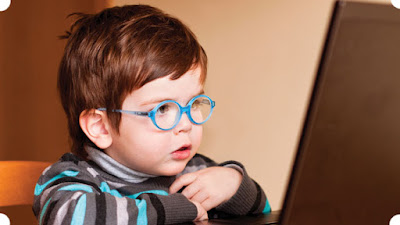 |
| Fig:- child with Glass |
The refraction in children with refractive error is possibly the most interesting aspect of refractionist’s job. The children up to the age group of 8 years are at the risk of developing squint or amblyopia. Uncorrected or undercorrected refractive error are one of the reasons. With adult patients, the examiner can normally place reasonable confidence in the answers given to questions asked in the subjective part of refraction. These answers can help substantiate the objective findings. With the child, the objective findings are critical in determining the true refractive error. With very young children, subjective questioning is absolutely impossible. Although autorefraction can be used reasonably successfully on older children, unsatisfactory accommodation control and daunting size of the instrument rules out its use on younger children.
 |
| Fig:- Amblyopia |
Another important aspect is to know the development of visual system of a child. At birth a baby’s eye is about 75% of the size of an adult eye, i.e. the baby is born with hyperopia with an average error of +2.00D. Premature baby have been shown to be less hyperopic. During the first two years of life, the ocular structures continue to develop. The most rapid decline in hypermetropia occurs between 6 months to 2 years of age in normally developing eyes. However, children who develop strabismus do not show emmetropization and demonstrate either increasing hypermetropia or no change in refractive error. The newborn’s visual acuity is approximately 20/200. Vision slowly improves to 20/20 by age of 2 years. Color vision is present at birth.
Another important fact to be kept in mind is that there is high prevalence of against the rule astigmatism in the newborn infants than in adults. The age of 3.5 years is an important milestone in the development of astigmatism. The prevalence of astigmatism drops significantly by this age and there is a shift in the prevalence of astigmatism as with the rule astigmatism appears. After 5 years of age, with the rule gains prevalence.
The uncorrected hypermetropic child overcomes some or all of his hypermetropia by exercising extra accommodation. When glasses are worn for the first time, the accommodation may not relax and the vision will be blurred. Usually accommodation relaxes after a few days if the glasses are continued. At times accommodation fails to relax and under such condition prescription needs to be reduced. Cycloplegic refraction is necessary to obtain an accurate retinoscopy results in infants and children. If this is done some degree of ametropia will be found in most cases and a clinical judgment must be exercised to decide whether spectacle will be of use or not. While refracting the eyes of the children, care must be taken to:
• Be very casual and friendly to them
• Engage them to the fullest and ensure that they are given the full attention
• Offer things which interest them like toys, candies and colorful objects
• Do not force any test. Go with the mood of the child
• If the child is comfortable with his parents close to him, let them be so
• Counseling is very critical for the first time wearers.
The important thing to remember in the mind is that one of the reasons for checking young children’s eyes is not to detect myopia but to find amblyopia.





0 Comments